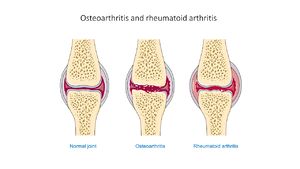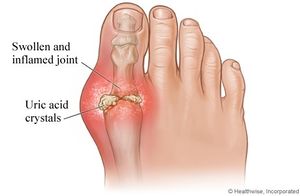Arthritis: Difference between revisions
(page creayed, text, ref) |
No edit summary |
||
| Line 6: | Line 6: | ||
</div> | </div> | ||
== Overview == | == Overview == | ||
[[File:Athritis.jpg|right|frameless]] | |||
Arthritis is a broad and complex topic with many types, subtypes, and variations. It is defined as an acute or chronic joint inflammation that often co-exists with pain and structural damage. Arthritis affected both the Neanderthals and ancient Egyptians, Arthritis describes a set of symptoms that includes pain, stiffness, and joint deformities subsequent to an inflammatory process. The destructive process can occur through multiple pathways. Knowing the type of arthritis a person has means that informed decisions can be made. | Arthritis is a broad and complex topic with many types, subtypes, and variations. It is defined as an acute or chronic joint inflammation that often co-exists with pain and structural damage. Arthritis affected both the Neanderthals and ancient Egyptians, Arthritis describes a set of symptoms that includes pain, stiffness, and joint deformities subsequent to an inflammatory process. The destructive process can occur through multiple pathways. Knowing the type of arthritis a person has means that informed decisions can be made. | ||
Arthritis can refer to over 150 different conditions that affect the muscles, bones and joints. These include: | Arthritis can refer to over 150 different conditions that affect the muscles, bones and joints. These include: | ||
* Degenerative disease (osteoarthritis) | * Degenerative disease ([[osteoarthritis]]) | ||
* Auto-immune or auto-inflammatory processes (rheumatoid arthritis and ankylosing spondylitis) | * Auto-immune or auto-inflammatory processes ([[Rheumatoid Arthritis|rheumatoid arthritis]] and [[Ankylosing Spondylitis|ankylosing spondylitis]]) | ||
* Crystal deposition (gout and pseudogout) | * Crystal deposition ([[gout]] and pseudogout) | ||
* Infection (septic arthritis) | * Infection ([[Septic (Infectious) Arthritis|septic arthritis]]) | ||
* Idiopathic (juvenile idiopathic arthritis). | * Idiopathic ([[Juvenile Rheumatoid Arthritis|juvenile idiopathic arthritis]]). | ||
Many diseases can result in arthritis. Examples include systemic lupus erythematosus, psoriasis, Lyme disease, reactive arthritis, and celiac disease among numerous others.<ref name=":0">Senthelal S, Thomas MA. [https://www.ncbi.nlm.nih.gov/books/NBK518992/ Arthritis]. InStatPearls [Internet] 2019 Aug 22. StatPearls Publishing. Available from: https://www.ncbi.nlm.nih.gov/books/NBK518992/ (last accessed 23.12.2019)</ref> | Many diseases can result in arthritis. Examples include [[Systemic Lupus Erythematosus|systemic lupus erythematosus]], [[Psoriatic Arthritis|psoriasis]], [[Lyme Disease|Lyme disease]], [[Reactive Arthritis|reactive arthritis]], and [[Celiac Disease (Coeliac Disease)|celiac]] disease among numerous others.<ref name=":0">Senthelal S, Thomas MA. [https://www.ncbi.nlm.nih.gov/books/NBK518992/ Arthritis]. InStatPearls [Internet] 2019 Aug 22. StatPearls Publishing. Available from: https://www.ncbi.nlm.nih.gov/books/NBK518992/ (last accessed 23.12.2019)</ref> | ||
=== Healthcare Team Management === | === Healthcare Team Management === | ||
| Line 29: | Line 30: | ||
Rheumatoid arthritis is a disease in which the immune system attacks the joints, beginning with the lining of joints. | Rheumatoid arthritis is a disease in which the immune system attacks the joints, beginning with the lining of joints. | ||
[[File:Gout foot.jpg|right|frameless]] | |||
Gout occurs when uric acid crystals form when there's too much uric acid in the blood. | Gout occurs when uric acid crystals form when there's too much uric acid in the blood.See image | ||
Infections or underlying disease, such as psoriasis or lupus, can cause other types of arthritis. | Infections or underlying disease, such as psoriasis or lupus, can cause other types of arthritis. | ||
| Line 36: | Line 37: | ||
== Clinical Presentation == | == Clinical Presentation == | ||
Arthritis affects people in different ways and each condition will have specific symptoms. However, common symptoms are: | |||
* pain | |||
* swelling, redness and warmth in a joint | |||
* muscular aches and pain | |||
* stiffness or reduced movement of a joint | |||
* general symptoms such as fatigue and feeling unwell.<br> | |||
== Diagnostic Procedures == | == Diagnostic Procedures == | ||
Numerous exams and tests are needed to diagnose which arthritis is present. Including | |||
* medical history – finding out about symptoms, family history, other health problems in the past | |||
* physical examination – look for redness and swelling in and around the joint, and check out the range of movement of your joints. Depending on the type of arthritis also look for rashes, check your eyes and throat, and measure your temperature | |||
* scans and other tests – again, depending on the type of arthritis test may include: blood tests to check for levels of inflammation in blood or specific genetic markers; x-rays; ultrasound; CT (computed tomography) or MRI (magnetic resonance imaging) | |||
* referral to a specialist – if appropriate your doctor will refer you to a specialist, often a rheumatologist, for diagnosis and specialised management of your condition.<ref>Better Health [https://www.betterhealth.vic.gov.au/health/conditionsandtreatments/arthritis Arthritis explained] Available from: https://www.betterhealth.vic.gov.au/health/conditionsandtreatments/arthritis (last accessed 23.12.2019)</ref> | |||
== Outcome Measures == | == Outcome Measures == | ||
Revision as of 07:39, 23 December 2019
Original Editor - Your name will be added here if you created the original content for this page.
Lead Editors
Overview[edit | edit source]
Arthritis is a broad and complex topic with many types, subtypes, and variations. It is defined as an acute or chronic joint inflammation that often co-exists with pain and structural damage. Arthritis affected both the Neanderthals and ancient Egyptians, Arthritis describes a set of symptoms that includes pain, stiffness, and joint deformities subsequent to an inflammatory process. The destructive process can occur through multiple pathways. Knowing the type of arthritis a person has means that informed decisions can be made.
Arthritis can refer to over 150 different conditions that affect the muscles, bones and joints. These include:
- Degenerative disease (osteoarthritis)
- Auto-immune or auto-inflammatory processes (rheumatoid arthritis and ankylosing spondylitis)
- Crystal deposition (gout and pseudogout)
- Infection (septic arthritis)
- Idiopathic (juvenile idiopathic arthritis).
Many diseases can result in arthritis. Examples include systemic lupus erythematosus, psoriasis, Lyme disease, reactive arthritis, and celiac disease among numerous others.[1]
Healthcare Team Management[edit | edit source]
Arthritis may be a disease of the joint but it also has systemic repercussions. The management of arthritis is ideally done by an interprofessional team that includes a nurse, dietitian, rheumatologist, physical therapist, orthopedic surgeon, pain specialist, pharmacist, and a Physician.
Almost all patients may benefit from a physical therapy. Ample evidence indicates that water-based exercise can diminish pain and improve joint function. Further, loss of weight also decreases the stress on the joint.
Polypharmacy is a major concern in these patients because of the need to resolve the pain, hence the pharmacist should closely monitor the medications to prevent serious drug interactions and if narcotics are required, monitor for overuse[1].
Mechanism of Injury / Pathological Process[edit | edit source]
Arthritis is the swelling and tenderness of joints. The main symptoms of arthritis are joint pain and stiffness, which typically worsen with age. The most common types of arthritis are osteoarthritis and rheumatoid arthritis.
Osteoarthritis causes cartilage to break down.
Rheumatoid arthritis is a disease in which the immune system attacks the joints, beginning with the lining of joints.
Gout occurs when uric acid crystals form when there's too much uric acid in the blood.See image
Infections or underlying disease, such as psoriasis or lupus, can cause other types of arthritis.
Clinical Presentation[edit | edit source]
Arthritis affects people in different ways and each condition will have specific symptoms. However, common symptoms are:
- pain
- swelling, redness and warmth in a joint
- muscular aches and pain
- stiffness or reduced movement of a joint
- general symptoms such as fatigue and feeling unwell.
Diagnostic Procedures[edit | edit source]
Numerous exams and tests are needed to diagnose which arthritis is present. Including
- medical history – finding out about symptoms, family history, other health problems in the past
- physical examination – look for redness and swelling in and around the joint, and check out the range of movement of your joints. Depending on the type of arthritis also look for rashes, check your eyes and throat, and measure your temperature
- scans and other tests – again, depending on the type of arthritis test may include: blood tests to check for levels of inflammation in blood or specific genetic markers; x-rays; ultrasound; CT (computed tomography) or MRI (magnetic resonance imaging)
- referral to a specialist – if appropriate your doctor will refer you to a specialist, often a rheumatologist, for diagnosis and specialised management of your condition.[2]
Outcome Measures[edit | edit source]
add links to outcome measures here (see Outcome Measures Database)
Management / Interventions[edit | edit source]
add text here relating to management approaches to the condition
Differential Diagnosis[edit | edit source]
add text here relating to the differential diagnosis of this condition
Resources[edit | edit source]
add appropriate resources here
References[edit | edit source]
- ↑ 1.0 1.1 Senthelal S, Thomas MA. Arthritis. InStatPearls [Internet] 2019 Aug 22. StatPearls Publishing. Available from: https://www.ncbi.nlm.nih.gov/books/NBK518992/ (last accessed 23.12.2019)
- ↑ Better Health Arthritis explained Available from: https://www.betterhealth.vic.gov.au/health/conditionsandtreatments/arthritis (last accessed 23.12.2019)








